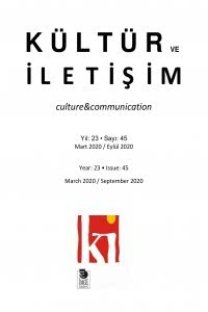Post-Hümanist ve Feminist Perspektiften Bedenin Sanatsal Dönüşümü
Modernist vizyonda önem kazanan ilerleme düşüncesi, kurguladığı gelecek fikrini postmodernizmle birlikte sınırlarını aşma odaklı tasarlanmış bir teknolojiyle ortaya koymaktadır. Modernizmle net bir kimliğe bürünen kitleler, post-modernizmle kimliğin ötesine geçerek alternatif var oluş biçimlerine şahitlik ederler. Bilimkurgu edebiyatının ve sinemasının hâkim olduğu söylemler, dijital çağın getirdiği tasarımlarla görsel kültürün her disiplinine dâhil olmaya başlar ve modern dönemde gelişen evrim düşüncesi, post-modernizmle beraber kararsızlık içindeki beden formuyla görselleşir. Günümüz temsilinde ise bu söylemler insan ve mekaniğin birleşmesinden oluşan siborg teknolojisiyle kendisini göstermektedir. 20. yüzyılın ilk yarısında sanat dünyasına hâkim olan Fütürizm, Dadaizm ve Sürrealizm temsilinin ardından meydana gelen radikal gelişmeler, sanatsal alanda da gelecek odaklı bir dünya temsiline imkân sağlamıştır. 1970’lerle ortaya çıkan ikinci dalga feminist hareket ve post-humanist anlayışın filizlenen çerçevesi, ırk, köken ve cinsiyet olmadan sağlanabilecek eşitlikçi bir insan merkezci yapıyı sanat alanında bedenin dönüştürülmesiyle ortaya koymuştur. Fütürist anlayışla, alternatif beden figürasyonları, biyo-teknolojinin sağladığı olanaklar doğrultusunda, sanat disiplinlerinde de yer bulmuştur. Makale, radikal hayal gücüyle katkıda bulunulmuş olan dönüştürülmüş bedenlerin sunumunun post-humanist ve feminist düşüncenin ifadesiyle gerçekleşen alternatif yaşam formlarının sanat alanındaki karşılıklarını vurgulamaktadır.
Anahtar Kelimeler:
Post-modernizm, Post-hümanizm, Siborg, Görsel Sanatlar
A Feminist and Post-Humanist Reading of the Transformation of the Body Through Art
The notion of innovation which gains importance in the modernist vision, along with postmodernism puts forth its imagined idea of future, with technology designed to go beyond its own borders. Masses who adopted clear identities with modernism have witnessed to postmodernism’s alternative styles of existence beyond identity. Through designs brought by the digital age, expressions, originally mastered by science-fiction literature and cinema, have become adopted by every discipline within visual culture. The thought of evolution developed in the modern era has become visualised in post-modernism with the indecisive form of the human body. In today’s depiction, it stands out with cyborg technology –a combination of human and machine. Radical developments which followed the representations of Futurism, Dadaism and Surrealism, which were dominant trends in art in the first half of the 20th century, provided wide opportunities to art to depict a future-focused world. The emerging framework within the second wave of the feminist movement, as well as the post-humanist notion, showed that a human-centred and egalitarian structure without race, origin or gender, could be possible by transforming the human body through art. With a futuristic understanding, alternative body figurations, now available via opportunities brought by bio-technology, have found their places in disciplines of art. This article highlights the equivalent of aforementioned aspects in art, of the presentation of transformed bodies, assisted by radical imagination, created by the expression of post-humanist and feminist thought
Keywords:
Postmodernism, Post-humanism, Cyborg, Visual arts,
- ISSN: 1301-7241
- Yayın Aralığı: Yılda 2 Sayı
- Başlangıç: 1998
- Yayıncı: İmge Kitabevi Yayınları
Sayıdaki Diğer Makaleler
İzmir’de 35 ½ Olmanın Kentsel Orta Sınıf Dinamikleri
Barış Kadar, Barış GazeteciliŞi de Gerekli: “Barış GazeteciliŞi Elkitabı” Üzerine
Kocan Kadar Konuş ya da Son Dönem Türkiye Sinemasının “Hayırlısıyla” Bekâr Kadın Karakter Hizalaması
Medyada Gerekli Şiddet Söylemi: Türkiye’deki Terör Saldırıları Üzerine Bir İnceleme
Post-Hümanist ve Feminist Perspektiften Bedenin Sanatsal Dönüşümü
Bir Fincan Türk Kahvesi Eşliğinde Bir Canlandırma Belgeselin Hikâyesi
Kimlik Avadanlığının Taşıdıkları: İşlevsel/Simgesel Bir Eşya Olarak Erkek Cüzdanı
Okur Yorumlarında Suriyeli Mültecilere Yönelik Eğilimler: Hürriyet Gazetesi Örneği
“Rapin Krallarından Geçtim, Gönül Sultanlarına Bağlandım”: Türkiye’de İslami ve Tasavvufi Rap Müzik
